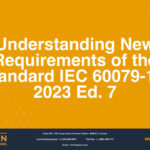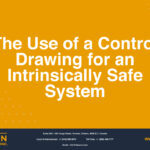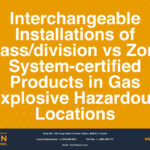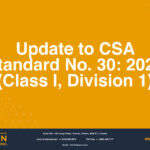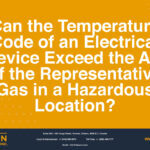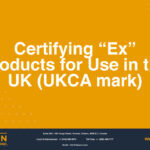
Should an Ex nA marking on your product be changed to Ex ec?
When Standards change, manufacturers should be aware of the changes and should update their certifications accordingly. A relatively recent change to IEC Standards is an example.
An “Ex nA” (non-arcing) marking, prior to a change in the International Electrotechnical Commission (IEC) Standards, was used to designate electrical devices safe to be installed and used in hazardous locations because of the specific protection technique for non-arcing equipment – absence of an ignition source. Given this protection technique, electrical equipment such as electrical machines, transformers, heaters, power supplies, and measurement equipment, to name a few, could be safely installed in Zone 2 installations, making this marking very popular.
Provision of this marking, Ex nA, was based on compliance with the IEC Standard IEC 60079-15. Products complying with the 4th edition of IEC 60079-15 are still able to bear the mark Ex nA, but this Standard has been updated with a new requirement in Ed 5. The new edition of IEC 60079-15 does not contain Ex nA anymore. The new edition, called IEC 60079-7, introduced the “Ex ec” marking which basically replaces the “Ex nA” marking. Both markings indicate the same degree of protection and compliance. Both illustrate use of the non-arcing protection technique to achieve compliance with the Standards.
Installed products that are already in compliance are still safe and no action is mandatory for them, based on the old markings. Manufacturers who continue to build the same devices, however, should once again prove compliance (with the new Standard) and obtain the new marking (Ex ec) as they go forward. Such updating of the marking is seen as critical to remaining competitive and will give end-users confidence that the products comply with latest technical knowledge and Standards.
The full marking of “Ex ec” is indicated in the following examples:
IECEx marking: Ex ec IIC T6 Gc
ATEX marking: II 3G Ex ec IIC T6 Gc
USA Zone marking: Class I, Zone 2, AEx ec IIC T6 Gc
Canada Zone marking: Ex ec IIC T6 Gc
At present, there is no specified timeline by which Ex nA marking must be replaced. Such a requirement may be expected within a few years, however. Keep in mind, too, that many manufacturers in the marketplace are already updating their existing certificates to achieve the revised marking. It is therefore in your best interests to update any Ex nA markings as an illustration to your consumers that you are manufacturing a product that meets current Standards. One thing you should know is that, for new products, compliance with Ex ec is the right path to take, and it is the only choice for some type of certifications.
So, what’s involved in updating your existing Ex nA marking to the current Ex ec marking? Standard IEC 60079-7 provides a gap analysis table in the first pages to help readers understand the changes required to update Ex nA to Ex ec. There are three types of changes: Minor and Editorial changes, Extension (addition of technical options) and Major Technical changes (addition of technical requirements, increase of technical requirements). What’s involved really depends on the type of product and which type of changes are applicable from the gap analysis checklist. If any of the Major Technical changes apply to the product, then compliance needs to be proven through additional testing.
The best strategy, before approaching a certification agency, is to complete the gap analysis checklist for your product. Identify which of the three types of changes apply. Explore how they can be achieved and only then take the proper steps to meet them.
Request a Consultation
Complete the form below to get started.

